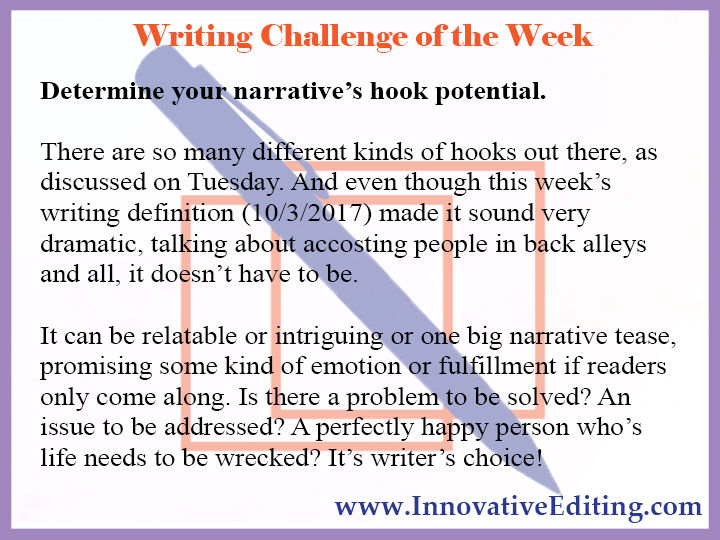What Kind of Narrative Hook Can Your Story Support?
- Jeannette DiLouie
- Oct 5, 2017
- 4 min read

In our list of challenges, we’ve come full circle back to the beginning of your story. But this time, we’re not talking about writing your opening paragraph(s). We’re talking about honing your opening paragraph(s) with a narrative hook. Like this:
Determine your narrative’s hook potential.
There are so many different kinds of hooks out there, as discussed on Tuesday. And even though this week’s writing definition (10/3/2017) made it sound very dramatic, talking about accosting people in back alleys and all, it doesn’t have to be.
It can be relatable or intriguing or one big narrative tease, promising some kind of emotion or fulfillment if readers only come along. Is there a problem to be solved? An issue to be addressed? A perfectly happy person whose life needs to be wrecked? It’s writer’s choice!
As challenges go, that’s all well and good. But let’s give you more to work with by actually listing off some fiction and non-fiction published hooks. Here are three examples of how to effectively hook a reader…
Daughters of Rome by Kate Quinn:
A hand.
Just a little girl’s hand like any other, plump-fingered and a little sticky, but for a moment he saw blood all over it.
“Interesting,” Nessus gulped. The girl stared up at him, expectant, and he looked at her palm again, hoping it had been a trick of the light. Maybe a shadow. But no, there it was: not a shadow but blood.
You’re seeing things, he told himself. You’re seeing things.
“What,” the child said, curious.
He swallowed a sudden burst of nervous laughter. Wasn’t an astrologer supposed to see things when he looked at the stars, or into a palm?
But he never had before, not once since he’d gotten started in this business. Astrology wasn’t about truth, after all – it was about pleasing the clients. Telling pregnant women that their stars foretold healthy sons; telling legionaries their futures held medals and glory. What successful astrologer told anybody there was enough blood in their hand to soak all Rome?
What’s the appeal here? It’s intense foreshadowing that promises lots of drama and raises a lot of questions along with it.
Who is this little girl with the blood-drenched hands?
What’s so special or horrific about her?
How soon will the foreshadowing come true?
That particular narrative hook is quite arresting, though it doesn’t have to be. It can be 180 degrees different in its appeal, as evidenced below.
Waiting for Paint to Dry by Lia Mack:
Not a day goes by that I don’t see the ocean or run alongside its gray-blue expanse. It’s the only place I feel free. Pounding the sand with every step I take, I envision my stride taking me farther and farther away. I only wish I could run on water.
The Pacific Ocean nips at my heels, and I feel the July sun working its way through the fog to warm my skin. My father is ahead of me, but we’re not racing today. Enjoying the feel of the sand as it pushes back against every step, we’re just running to clear our minds and feel the chilled morning breeze brush against the sweat on our skin.
I see him look back and smile, waving me on. We’ve passed the pier twice already and are now headed south where we’ll make a U-turn at the lagoon and head back up toward home. Our typical morning run along the beach. And it’s nice to be doing it together again. I’ve missed my dad.
This one isn’t dramatic. It’s not filled with the promise of horror or conflict or excitement. It simply is. Describing a regular woman in a regular situation with regular emotions, this narrative hook sets up what sounds like a relatable read.
And relatable reads can be just as powerful in drawing in an audience. So can a quiet air of mystery or intrigue, such as with:
The Immortal Life of Henrietta Lacks by Rebecca Skloot
There’s a photo on my wall of a woman I’ve never met, its left corner torn and patched together with tape. She looks straight into the camera and smiles, hands on hips, dress suit neatly pressed, lips painted deep red. It’s the late 1940s and she hasn’t yet reached the age of thirty. Her light brown skin is smooth, her eyes still young and playful, oblivious to the tumor growing inside her – a tumor that would leave her five children motherless and change the future of medicine. Beneath the photo, a caption says her name is “Henrietta Lacks, Helen Lane or Helen Larson.”
Those 103 words above also manage to paint a mental picture: one of a pretty young woman who’s loved and loving and worth remembering. It’s only a matter of why that’s left to be discovered – by reading beyond the opening paragraphs.
That right there is how your story – fiction or non-fiction – is supposed to start: with a narrative hook that makes potential readers want to become definite readers.




